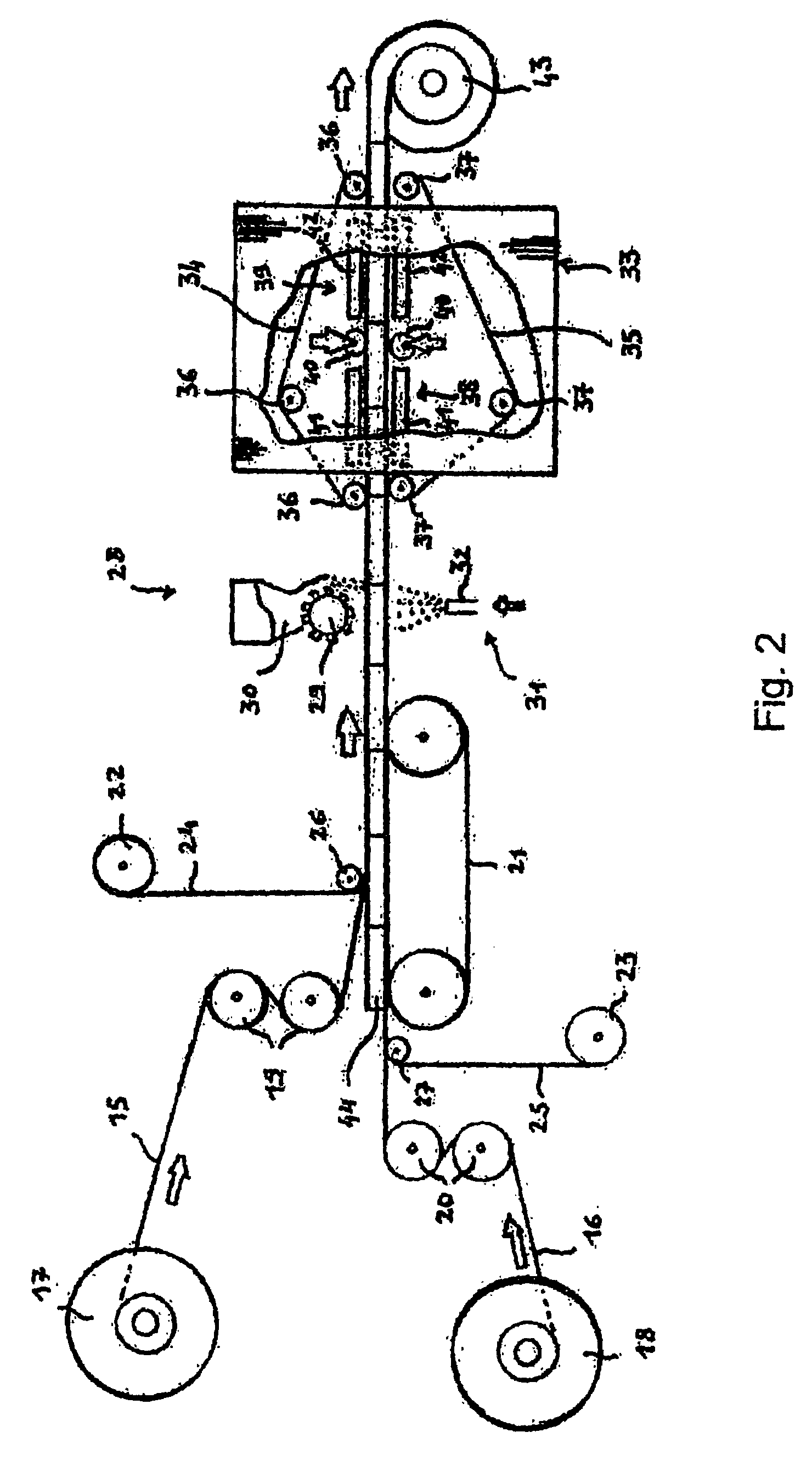Method and device for making a composite plate
a composite plate and method technology, applied in the field of composite plate making methods and devices, can solve the problems of high cost of machines, inability to use extrusion, and high production costs of films, and achieve the effect of reducing the “marking” effect and improving the adhesion of the coating layer
- Summary
- Abstract
- Description
- Claims
- Application Information
AI Technical Summary
Benefits of technology
Problems solved by technology
Method used
Image
Examples
example 1
[0091]The installation described in FIG. 1 was used to manufacture a composite sheet 1.5 m in width and 1.5 mm in thickness, consisting of 60% glass by weight and 40% polypropylene by weight.
[0092]Assemblies of continuous yarns, 750 g / m2 in weight and 1.5 m in width, comprising, as warp and as weft, intermingled yarns formed from 1870-tex intermingled rovings containing 60% glass by weight and 40% polypropylene by weight, were used, the yarns being bound together in the weft direction by stitching-knitting with a polypropylene binding yarn.
[0093]Two assemblies coming from two reels were superposed on the conveyor belt and a powder of a polyolefin-based thermoplastic alloy (Plascoat® Talisman sold by Plascoat) was applied to the top side of the assembly in an amount of 500 g / m2. The assembly, running at a speed of 1.5 m / minute, was heated between the infrared radiation panels (length: 1 m; temperature: 200° C.) and then passed between the rolls (diameter: 300 mm; temperature: 40° C.;...
example 2
[0095]The installation of FIG. 2 was used.
[0096]A “jet fluid”-bonded 70 g / m2 polyester veil (reference NLC 10 / 701 sold by PGI) was deposited on two 745 g / m2 wovens formed from 1870 tex intermingled rovings containing 60% glass by weight and 40% polypropylene by weight, bulk-colored black, in a 2×2 twill, 1.5 m in width, and the powder of thermoplastic alloy of example 1 was applied in an amount of 500 g / m2. The assembly was introduced into a double belt press comprising a heated zone at 200 °C., a two-roll calender (pressure: 1.5 bar (0.15 MPa)) and a cooling zone at 20° C. The press operated at a speed of 2 meters per minute.
[0097]A sheet 1.5 mm in thickness comprising a uniform glossy coating layer, white in color, was obtained.
example 3
[0098]The conditions of example 1 were used. A 50 g / m2 glass veil was deposited on a 1485 g / m2 woven formed from 1870 tex interminged rovings containing 60% glass by weight and 40% polypropylene by weight, in a 2×2 twill with sides of 1.5 m, and the powder of thermoplastic alloy of example 1 was applied in an amount of 500 g / m2.
[0099]The assembly, running at a speed of 1.5 m / min, was heated between the infrared radiation panels (temperature: 220° C.) and then passed into the calender.
[0100]The composite sheet obtained had a thickness of 1.5 mm. It was cut up and heated to 220° C. for 1 minute in an infrared oven, it was then transferred into a press, consisting of a rectangular mold and a countermold regulated to 60° C., and subjected to a 40 bar (4 MPa) pressure for 1 minute.
[0101]After demolding, a box 150 mm in width, 200 mm in length and 20 mm in height, having a uniform coating and no material distribution defect, was obtained.
PUM
| Property | Measurement | Unit |
|---|---|---|
| thickness | aaaaa | aaaaa |
| thickness | aaaaa | aaaaa |
| width | aaaaa | aaaaa |
Abstract
Description
Claims
Application Information
 Login to View More
Login to View More - R&D
- Intellectual Property
- Life Sciences
- Materials
- Tech Scout
- Unparalleled Data Quality
- Higher Quality Content
- 60% Fewer Hallucinations
Browse by: Latest US Patents, China's latest patents, Technical Efficacy Thesaurus, Application Domain, Technology Topic, Popular Technical Reports.
© 2025 PatSnap. All rights reserved.Legal|Privacy policy|Modern Slavery Act Transparency Statement|Sitemap|About US| Contact US: help@patsnap.com


